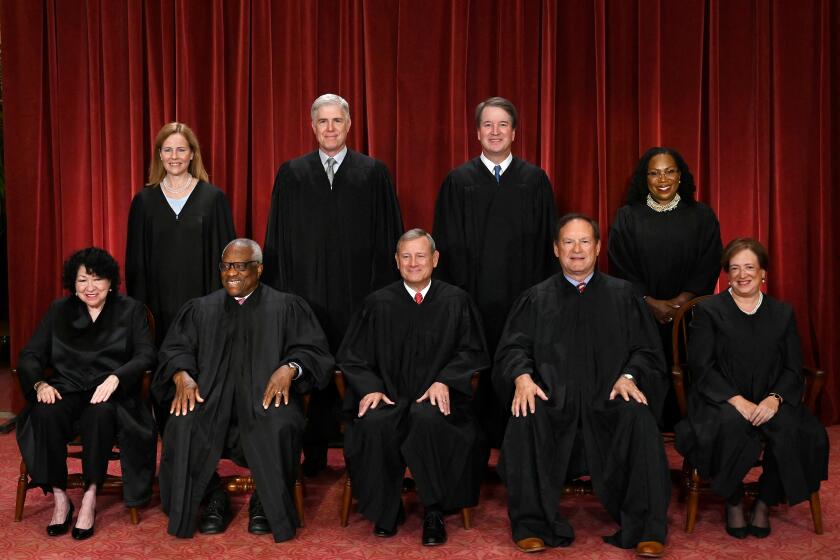Put State School Bond to a June Vote
- Share via
When California’s legislators turned off the lights at the Capitol last fall and went home, they left school districts in the dark about how the state would meet its responsibility for providing school facilities.
The California Supreme Court has put the state’s obligation simply: Education is a “fundamental state interest.” The state’s responsibility in education includes ensuring that children have a decent place to learn, especially in a time of explosive school overcrowding due in part to new state policy ordering smaller classes.
A surge of 1 million new schoolkids will fill a dozen more classrooms every day, seven days a week, between 1995 and 2005. Class-size reduction implemented last year immediately cut classroom capacity by 50% in the primary grades and in a flash created the need for at least 20,000 additional classrooms across the state. This at a time when deteriorating school buildings, most of them built more than a generation ago, are in desperate need of maintenance and modernization.
Now, to his credit, Gov. Pete Wilson is trying to bring the problem to the voters for action on the June ballot. He is proposing a multiyear series of state bonds for new school facilities.
The governor also proposes a way to make it easier for school districts to raise their share of the expense: allowing voters to approve local bonds by a majority, rather than the two-thirds margin currently required by the state Constitution. But this sort of linkage is what left the problem in a state of legislative political paralysis last fall.
The last time Californians were allowed to vote on a statewide school bond, in March 1996, a remarkable 62% voted yes. That was before the enormously popular introduction of class-size reduction, and there is no reason to presume that electoral enthusiasm has cooled.
A school bond can be defended as good policy: California can’t afford to ignore its school facility crisis. A school bond is apparently good politics, too: A Field Poll pegged education as the clear front-runner among voter hot-button issues. So why the legislative inaction?
It wasn’t due to a lack of interest. Last summer and fall, countless meetings and committee hearings were held in Sacramento to hammer out a response to the overcrowding crisis. On the table were a statewide school bond, a proposal to lower the vote threshold for passing local school bonds and reform of the state school building program.
The subsequent legislative package quickly collapsed under its own weight, burdened by the special treatment that developers consistently demand to escape their responsibility to address development impacts on schools. The package was neither comprehensive nor politically viable. The votes weren’t--and still aren’t--there to lower the local school bond vote threshold from the current two-thirds super majority. And the developers are steadfast in their refusal to back any agreement that would preserve sensible land-use decision-making authority by cities and counties to ensure adequate school facilities.
All of these issues need eventual resolution. It would be irresponsible to postpone them again. It would be worse than irresponsible to hold our schoolchildren hostage indefinitely.
This situation can’t wait. A million new students will have crowded into our schools in the decade ending in 2005. That’s like moving the entire student populations of Oregon, Idaho and Nevada into California, with no place to put them. We need state bond dollars for this; the alternatives are increased local property taxes or higher impact fees charged on new housing.
What about the 20,000-plus new classrooms needed just for class-size reduction? In the best of all possible worlds, we would be looking at 1,000 new elementary schools to provide these classrooms. Instead, for lack of money, we are expanding the second-class program of portable classrooms, crowding thousands and thousands of trailers onto already overburdened school sites, sacrificing playgrounds and fields.
Fortunately, there is still time for the legislators to act. They have until Monday to place a state school bond on the June ballot.
Gov. Wilson has fought for thoughtful reforms on the state level and has demonstrated tremendous commitment to the goal of lowering the threshold for the passage of local school bonds to a simple majority. However, those of us on the front lines of the classroom crowding crush hope that he will strongly consider disconnecting the parts of his proposal that could jeopardize passage of a state school bond. The nearly 1,000 local school districts across California and the 5 million schoolchildren they serve are counting on our legislators and the voters to do the right thing.
More to Read
Get the L.A. Times Politics newsletter
Deeply reported insights into legislation, politics and policy from Sacramento, Washington and beyond. In your inbox twice per week.
You may occasionally receive promotional content from the Los Angeles Times.









